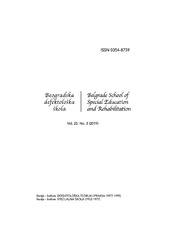Приказ основних података о документу
Motorički razvoj dece sa oštećenjem sluha
Motor development of children with hearing disability
| dc.creator | Sretenović, Ivana | |
| dc.creator | Nedović, Goran | |
| dc.date.accessioned | 2021-06-17T13:55:53Z | |
| dc.date.available | 2021-06-17T13:55:53Z | |
| dc.date.issued | 2019 | |
| dc.identifier.issn | 0354-8759 | |
| dc.identifier.uri | http://rfasper.fasper.bg.ac.rs/handle/123456789/3068 | |
| dc.description.abstract | Motorički razvoj je ključni aspekt dečijeg celokupnog razvoja i blagostanja. Deca sa oštećenjem sluha, pored teškoća u razvoju govora ili teškoća u socijalnom razvoju, često imaju i usporen motorički razvoj. Cilj rada je bio da se utvrdi nivo motoričkog razvoja dece sa oštećenjem sluha. Uzorak istraživanja činilo je ukupno 45 dece sa oštećenjem sluha, uzrasta 7-15 godina (AS = 10,67 SD = 3,34), oba pola (64,4% dečaka). Svi ispitanici su u trenutku testiranja bili uključeni u vaspitno-obrazovni proces. Za procenu nivoa motoričkog razvoja primenjena je baterija testova The Bruininks-Oseretsky Test of Motor Proficiency, 2nd edition (BOT-2, Bruininks & Bruininks, 2005). Metode deskriptivne statistike, T-test nezavisnih uzoraka i χ2 test korišćeni su u statističkoj obradi dobijenih podataka. Rezultati istraživanja su pokazali da se u odnosu na norme predviđene za određeni uzrast, ispitanici sa oštećenjem sluha nalaze u proseku, ispod i znatno ispod proseka kada je u pitanju motorički razvoj. Dobijeni rezultati mogu poslužiti u kreiranju adekvatnih i stimulativnih programa motoričkog razvoja za decu sa oštećenjem sluha. | |
| dc.description.abstract | Motor development is a key aspect of children’s overall development and well-being. In addition to speech or social development difficulties, children with hearing disability often have slow motor development. The aim of the study was to determine the level of motor development of children with hearing disability. The study sample consisted of a total of 45 children with hearing disability, aged 7-15 years (M = 10.67, SD = 3.34), both sexes (64.4% boys). At the time of testing, all participants were included in the educational proces. A battery of The Bruininks-Oseretsky Test of Motor Proficiency, 2nd edition (BOT-2; Bruininks & Bruininks, 2005) was used to assess the level of motor development. Descriptive statistics methods, independent sample T-test and χ2 test were used in the statistical processing of the obtained data. The results showed that compared to standards designed for specific age, children with hearing disability are on average, below average and well-below average when it comes to motor development. The obtained results can serve to create adequate and stimulating motor development programs for children with hearing disability. | |
| dc.rights | openAccess | |
| dc.rights.uri | https://creativecommons.org/licenses/by-sa/4.0/ | |
| dc.source | Beogradska defektološka škola | |
| dc.subject | oštećenje sluhai | |
| dc.subject | stimulativni program | |
| dc.subject | BOT-2 | |
| dc.subject | motor development | |
| dc.subject | hearing impairment | |
| dc.subject | stimulating programs | |
| dc.subject | BOT-2 | |
| dc.subject | motorički razvoj | |
| dc.subject | oštećenje sluha | |
| dc.subject | stimulativni programi | |
| dc.title | Motorički razvoj dece sa oštećenjem sluha | sr |
| dc.title | Motor development of children with hearing disability | |
| dc.type | article | |
| dc.rights.license | BY-SA | |
| dc.citation.epage | 33 | |
| dc.citation.epage | ||
| dc.citation.issue | 3 | |
| dc.citation.other | 25(3): 23-33 | |
| dc.citation.rank | M52 | |
| dc.citation.spage | 23 | |
| dc.citation.volume | 25 | |
| dc.identifier.fulltext | http://rfasper.fasper.bg.ac.rs/bitstream/id/3807/14.pdf | |
| dc.identifier.rcub | https://hdl.handle.net/21.15107/rcub_rfasper_3068 | |
| dc.type.version | publishedVersion |


